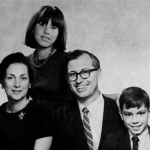 When Mark Curtis announced his resignation as third president of ¡˘∫œ≤ ◊ ¡œ’æ in the spring of 1975, few could say they’d changed the landscape of the college ‚Äî both aesthetically and academically ‚Äî more than he had.
When Mark Curtis announced his resignation as third president of ¡˘∫œ≤ ◊ ¡œ’æ in the spring of 1975, few could say they’d changed the landscape of the college ‚Äî both aesthetically and academically ‚Äî more than he had.
President Curtis oversaw an era of growth and construction at ¡˘∫œ≤ ◊ ¡œ’æ with the building of Mary Patterson Routt and Bessie Bartlett Frankel and Cecil Frankel Halls, the addition of Bette Cree Edwards Humanities Building, and the expansion of Ella Strong Denison Library. And that was just the architecture; the student body more than doubled in size under his tenure thanks to improved financial aid packages and bolstered faculty salaries.
“We have reached the point where the College has the innate strength to sustain the strains of a period of transition and even perhaps, to gain a new sense of purpose from the experience,” he wrote in his letter of resignation. “The accomplishments of the last ten and one-half years have resulted from genuine shared efforts.”
With any period of successful expansion comes trials; President Curtis often spoke of the “difficult, tense times” that coincided with the social turmoil of the mid-sixties and seventies, including confrontations with faculty and the Black Student Union. His presidency also involved leadership on the Claremont Consortium as provost.
Prior to ¡˘∫œ≤ ◊ ¡œ’æ, President Curtis was a member of the history department faculty at Williams College and at UCLA, where he also served as associate dean for the graduate division. He earned a bachelors, masters, and doctorate from Yale University and was also the recipient of a Guggenheim Fellowship and a Folger Shakespeare Library Fellowship.
Curtis ultimately left ¡˘∫œ≤ ◊ ¡œ’æ in 1976, but his legacy is visible any time one walks across campus. In later years, he confided that his successor should have been a woman, a forward-thinking suggestion he would live to see come to fruition before passing in the fall of 1994.

